
| 1997 1998 1999 2000 2001 Hilites | Page 1 - 2 - 3 - 4 - 5 - 6 - 7 - 8 - 9 |
LIMESTONE TABLET FRAGMENTS
|
In March we discovered an apparent termination offering in front of the carved stone bench. It included ceramic vessels, carbon deposits and fragments of a carved stone tablet approximately ten centimeters thick. The tablet is carved in much deeper relief than the stone bench.
(Click here for a plan of Temple XIX showing the location of the find.) These tablet fragments are part of the top portion of the limestone tablet discovered last season. (Click here for a drawing of the tablet as reassembled.) The size of this special deposit is approximately 5 square meters. A few large vault and roof stones that were in direct contact with the deposits, and all of the ceramic pots except for a few miniatures, were smashed in the roof fall. The excavation and conservation of the deposit was supervised by Site Archaeologist, Arnoldo Gonzalez Cruz, and Principle Investigator, Alfonso Morales C., and was conducted by archaeologists and conservation specialists of the Proyecto Grupo de Las Cruces. Excavation and conservation procedures began on April 10, 1999. First, a temporary workshop was created on the exposed stone slab floor of Temple XIX to the west of the special deposits. The workshop includes tables, a generator for electric lights, tools for excavation and conservation, and packaging materials for artifacts and samples. The rubble and large stones above the deposit were then removed by archaeologists working from the already cleared west side of the deposit and following it to the east, to expose all artifacts and the uppermost levels of organic and carbon deposits. All artifacts were pedestaled and documented in-situ. Soft wood tools and brushes were used, where possible, to prevent damage to the artifacts. The exposed special deposits were documented with digital, black and white, and color photographs at various stages of the excavation. Scale drawings were also made of all artifacts and carbon and organic deposits in-situ. Artifacts that were obscured by carbon or organic remains were drawn and photographed after the overlying deposits have been removed. Carbon, bones, and organic samples were taken with clean metal tools and stored in tin foil or glass containers and were removed in .02 m squares or less, depending on their size and shape. A portable grid was used to facilitate this process. Distinct macro-biotic remains (only carbonized wood so far) were removed whole where possible. A grid key was kept on graph paper so that the locations of all samples could be reconstructed during analyses of the remains. All samples and artifacts were tagged with unique lot, sample, and artifact identification numbers, and a separate list of these materials were kept on appropriate forms. The preservation conditions of all artifacts and organic remains were evaluated immediately by a team of INAH conservation specialists, and, where necessary, conservation and consolidation efforts were performed during the excavation and removal process according to their recommendations. For example, it was necessary to create and maintain humid micro climates for limestone and soft ceramic artifacts to prevent the crystallization of salts and carbonates. Salt and carbonate crystals would have widened existing cracks and left it difficult to remove deposits on the surfaces of the artifacts. Protective layers of acid free paper, moistened with solutions of water and alcohol, and covered with plastic, were applied where necessary as determined by the conservation specialists. A clear, obstacle free path was also constructed to facilitate the transportation of artifacts from the temple to the secure bodega at the compemento. All artifacts and samples were removed in appropriate protective containers. The carved stone tablets and tablet fragments, for example, were removed and stored in specially made wooden boxes with foam lining. After all of the artifacts, carbon deposits, and organic remains from the deposit as well as the carved stone tablet remains have been documented and removed, the interior architecture and/or contents of the carved stone bench will be excavated and documented following the same procedures described above. All artifacts will be cleaned, consolidated and restored by our team of INAH approved conservation specialists, and the most appropriate carbon, macrobiotic, and other organic remains will be selected for future physical and chemical tests and analyses. All field and artifact drawings will be inked and published in the P.G.C. annual reports, along with detailed descriptions of the artifacts, and of the conservation and restorations efforts. |
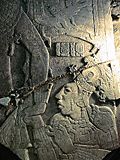
extreme zoom 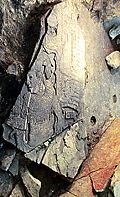
extreme zoom 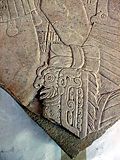
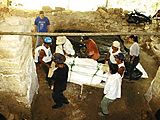
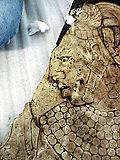
extreme zoom more photos in Archive |
